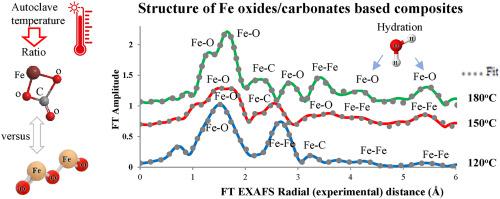当前位置:
X-MOL 学术
›
Solid State Sci.
›
论文详情
Our official English website, www.x-mol.net, welcomes your
feedback! (Note: you will need to create a separate account there.)
Atomic scale structure and surface chemistry of Fe oxides/carbonates-based composites precipitated at various temperatures via urea-supported hydrothermal synthesis
Solid State Sciences ( IF 3.4 ) Pub Date : 2020-08-01 , DOI: 10.1016/j.solidstatesciences.2020.106331 Natalia Chubar , Vasyl Gerda
Solid State Sciences ( IF 3.4 ) Pub Date : 2020-08-01 , DOI: 10.1016/j.solidstatesciences.2020.106331 Natalia Chubar , Vasyl Gerda

|
Abstract This is the first report of the atomic-scale structure in iron oxides/carbonates based composites produced at various autoclave temperatures from divalent Fe(II) precursor. It is also one of the first works which demonstrates how EXAFS simulation can be utilized to additionally characterize metal compound-based materials to estimate their properties associated with surface reactivity. Here we examine how greatly the autoclave temperature within a practical range of 120–180 °C affects the composition, structure, surface chemistry and adsorptive anion removal of three Fe-oxides/carbonates-built composites synthesized via urea-supported hydrothermal precipitation. Divalent Fe(II) precursor was used to promote redox transformations and consequently to increase number of phases/compounds. Complementary tools EXAFS, XPS and FTIR allowed to characterize the entire composites regardless of their crystallinity. It was defined that the autoclave temperature strongly influenced both the ratios between two substances (Fe oxides and Fe carbonates) in each material and speciation in each compound. Stronger reducing conditions at higher temperature in autoclave intensified generation of FeCO3-containing substances fraction of which was growing from 20.6 to 56.2–75.6% in the materials fabricated at 120, 150 and 180 °C, respectively. In neither of the three composites, local structure around Fe simulated using EXAFS oscillations reproduced arrangement of any known individual phase of Fe oxide or Fe carbonate. The data on adsorptive performance of the samples to six aqueous anions supported the recently proposed methodological suggestion which associates an extended x-ray absorption fine structure around the main atoms (here, Fe) in outer shells simulated using EXAFS oscillations with the material anion exchange ability. In this paper, we made another observation which for the first time relates the local structure in further shells fitted solely with O atoms with physisorbed water.
中文翻译:

通过尿素负载水热合成在不同温度下沉淀的铁氧化物/碳酸盐基复合材料的原子尺度结构和表面化学
摘要 这是在不同高压釜温度下由二价 Fe(II) 前驱体生产的基于氧化铁/碳酸盐的复合材料中原子级结构的第一份报告。这也是首批展示如何利用 EXAFS 模拟来额外表征基于金属化合物的材料以估计其与表面反应性相关的特性的作品之一。在这里,我们研究了高压釜温度在 120-180°C 的实际范围内对通过尿素支持的水热沉淀合成的三种铁氧化物/碳酸盐复合材料的组成、结构、表面化学和吸附阴离子去除的影响有多大。二价 Fe(II) 前体用于促进氧化还原转化,从而增加相/化合物的数量。补充工具EXAFS,无论结晶度如何,XPS 和 FTIR 都可以表征整个复合材料。据定义,高压釜温度对每种材料中两种物质(Fe 氧化物和 Fe 碳酸盐)之间的比率和每种化合物的形态都有很大影响。在高压釜中在较高温度下更强的还原条件加强了含 FeCO3 物质的生成,其中在 120、150 和 180 °C 下制造的材料中,FeCO3 物质的比例分别从 20.6% 增加到 56.2-75.6%。在这三种复合材料中,使用 EXAFS 振荡模拟的 Fe 周围的局部结构都没有再现任何已知的 Fe 氧化物或 Fe 碳酸盐单相的排列。样品对六种水性阴离子的吸附性能数据支持了最近提出的方法论建议,该建议将使用 EXAFS 振荡模拟的外壳中主要原子(此处为 Fe)周围的扩展 X 射线吸收精细结构与材料阴离子交换能力相关联. 在本文中,我们进行了另一项观察,首次将仅装有 O 原子的其他壳中的局部结构与物理吸附水联系起来。
更新日期:2020-08-01
中文翻译:

通过尿素负载水热合成在不同温度下沉淀的铁氧化物/碳酸盐基复合材料的原子尺度结构和表面化学
摘要 这是在不同高压釜温度下由二价 Fe(II) 前驱体生产的基于氧化铁/碳酸盐的复合材料中原子级结构的第一份报告。这也是首批展示如何利用 EXAFS 模拟来额外表征基于金属化合物的材料以估计其与表面反应性相关的特性的作品之一。在这里,我们研究了高压釜温度在 120-180°C 的实际范围内对通过尿素支持的水热沉淀合成的三种铁氧化物/碳酸盐复合材料的组成、结构、表面化学和吸附阴离子去除的影响有多大。二价 Fe(II) 前体用于促进氧化还原转化,从而增加相/化合物的数量。补充工具EXAFS,无论结晶度如何,XPS 和 FTIR 都可以表征整个复合材料。据定义,高压釜温度对每种材料中两种物质(Fe 氧化物和 Fe 碳酸盐)之间的比率和每种化合物的形态都有很大影响。在高压釜中在较高温度下更强的还原条件加强了含 FeCO3 物质的生成,其中在 120、150 和 180 °C 下制造的材料中,FeCO3 物质的比例分别从 20.6% 增加到 56.2-75.6%。在这三种复合材料中,使用 EXAFS 振荡模拟的 Fe 周围的局部结构都没有再现任何已知的 Fe 氧化物或 Fe 碳酸盐单相的排列。样品对六种水性阴离子的吸附性能数据支持了最近提出的方法论建议,该建议将使用 EXAFS 振荡模拟的外壳中主要原子(此处为 Fe)周围的扩展 X 射线吸收精细结构与材料阴离子交换能力相关联. 在本文中,我们进行了另一项观察,首次将仅装有 O 原子的其他壳中的局部结构与物理吸附水联系起来。











































 京公网安备 11010802027423号
京公网安备 11010802027423号